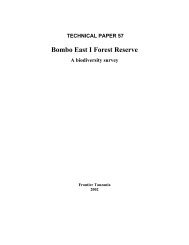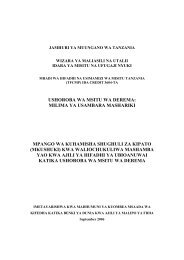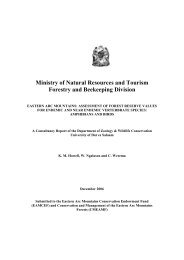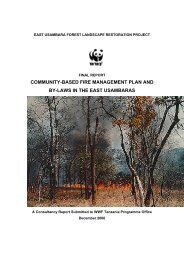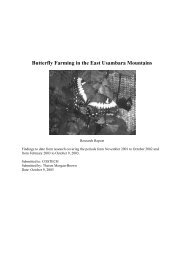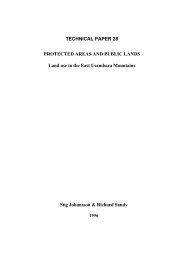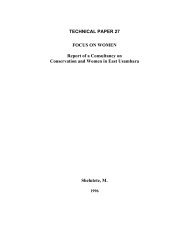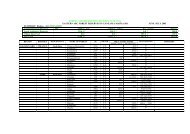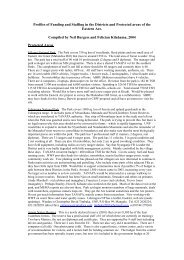Mgambo Forest Reserve: A biodiversity survey. - Eastern Arc ...
Mgambo Forest Reserve: A biodiversity survey. - Eastern Arc ...
Mgambo Forest Reserve: A biodiversity survey. - Eastern Arc ...
You also want an ePaper? Increase the reach of your titles
YUMPU automatically turns print PDFs into web optimized ePapers that Google loves.
<strong>Mgambo</strong> <strong>Forest</strong> <strong>Reserve</strong><br />
EXECUTIVE SUMMARY<br />
<strong>Mgambo</strong> <strong>Forest</strong> <strong>Reserve</strong> (FR) is located in the north-east of the main East Usambara<br />
Mountain range, adjacent to the savanna plateau that reaches into Kenya. <strong>Mgambo</strong> FR covers<br />
an area of 13.46 km 2 (1346 ha). It lies in the district of Muheza, Maramba Division, Tanga<br />
Region and covers land approximately 10 km north from Maramba town, located on latitude<br />
4 o 46’00” and longitude 38 o 45’15”. <strong>Mgambo</strong> FR was gazetted in July 1998, as delineated and<br />
described on the <strong>Forest</strong> and Beekeeping Division map number. Jb. 2291. It was gazetted<br />
primarily to protect the catchment areas supplying Bwiti, Mavovo, <strong>Mgambo</strong> and Daluni<br />
villages. The region has an average annual rainfall of between 1000 and 1500mm per year,<br />
falling principally from March to June although, in recent years, rain has been unpredictable<br />
and low. Vegetation cover within <strong>Mgambo</strong> <strong>Forest</strong> <strong>Reserve</strong> has previously been recorded as<br />
containing 1,295 ha of poorly stocked lowland forest and 51 ha of cultivation under lowland<br />
forest (Johansson, 1996). The <strong>biodiversity</strong> <strong>survey</strong> within <strong>Mgambo</strong> FR shows that this has now<br />
changed.<br />
As part of the East Usambara Conservation Area Management Programme, (EUCAMP),<br />
(formerly the East Usambara Catchment <strong>Forest</strong> Project), Frontier-Tanzania conducted a<br />
biological <strong>survey</strong> of <strong>Mgambo</strong> FR between April and June 2002 for a total of 10 research<br />
weeks. The systematic vegetation <strong>survey</strong> covered all parts of the reserve with a sampling<br />
intensity of 0.25%, the zoological <strong>survey</strong> was focussed on 4 ten night trapping sites and 2 two<br />
night sites. This report provides an inventory of the trees, shrubs, herbs, mammals, reptiles,<br />
amphibians, birds and butterflies recorded during the <strong>survey</strong>. The report also describes<br />
patterns of human disturbance within the reserve. The species richness, endemism and<br />
ecological affinities of the taxa recorded are summarised in Table 1.<br />
Table 1 Summary of <strong>biodiversity</strong> of taxa <strong>survey</strong>ed<br />
Taxon Total no. of<br />
species<br />
% forest<br />
dependent<br />
No. of<br />
non-forest<br />
species<br />
No. of<br />
endemic<br />
species<br />
No. of<br />
nearendemic<br />
species<br />
East Usambara Conservation Area Management Programme Technical Paper 59<br />
v<br />
No. of forest<br />
dependent<br />
endemics and<br />
near-endemics<br />
Trees and shrubs 128 5.0 29 1 12 2<br />
Mammals 45 9.5 12 0 3 1<br />
Birds 52 6.0 31 0 2 0<br />
Reptiles 20 10.0 18 0 2 0<br />
Amphibians 14 36.0 3 0 5 5<br />
Butterflies 138 17.0 44 0 11 7<br />
Total 397 n/a 137 1 35 15<br />
Relative to other reserves <strong>survey</strong>ed by Frontier-Tanzania, <strong>Mgambo</strong> FR has a low floral<br />
diversity and low to average faunal diversity.<br />
In terms of flora, <strong>Mgambo</strong> FR is made up of patches of several different vegetation types<br />
including dry lowland forest, riverine lowland forest, scrub forest, open woodland and<br />
miombo woodland (Brachystegia sp.). A large proportion of species recorded within <strong>Mgambo</strong><br />
FR were categorised as non-forest dwelling (Table 1). Lowland riverine forest and some of<br />
the lowland scrubby habitats were the most important habitats for endemic and near endemic<br />
species, althouth the majority of the reserve suffers substantially from fire and overgrazing<br />
disturbances. Only one plant species was identified as endemic to the Usambaras, this was<br />
Cassia abbreviata .<br />
Despite its small size, <strong>Mgambo</strong> <strong>Forest</strong> <strong>Reserve</strong> supports a high diversity of butterfly species<br />
and several near endemic amphibian species. The reserve is home to 3 endangered and 5<br />
vulnerable species according to the National Biodiversity Database (UDSM, 1997) and IUCN<br />
categories.



